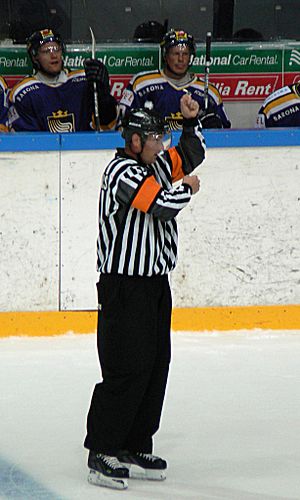Penalty (ice hockey) facts for kids
A penalty in ice hockey is like a time-out a player gets for breaking the rules during a game. When a player does something wrong, a referee or another game official will decide if a penalty is needed. Usually, the player has to sit in a special area called the penalty box for a short time. After that time is up, they can go back and play with their team. Some penalties are for small mistakes, while others are for more serious rule breaks.
Contents
What Are Penalties in Ice Hockey?
In ice hockey, a penalty is a punishment given to a player who breaks the rules. These rules help keep the game fair and safe for everyone. When a referee sees a player commit a foul, they will blow their whistle and signal a penalty. The type of penalty depends on how serious the rule break was.
Why Do Players Get Penalties?
Players get penalties for many reasons. Most penalties are given to stop dangerous plays or unfair advantages. For example, hitting another player with your stick too high is called "high-sticking." Tripping an opponent is another common penalty. These rules make sure the game stays exciting but also safe for all players.
What Happens After a Penalty?
When a player gets a penalty, they usually have to leave the ice and sit in the penalty box. This box is a special seating area usually located between the two team benches. The player stays there for a set amount of time, like two minutes or five minutes. While they are in the penalty box, their team has to play with one less player on the ice. This is called a "power play" for the other team.
Different Types of Penalties
There are many different types of penalties in ice hockey. Some common ones include:
- Minor Penalties: These are usually for two minutes. Examples are tripping, holding, or hooking an opponent.
- Major Penalties: These are more serious and last for five minutes. They are given for dangerous actions like fighting or serious high-sticking.
- Misconduct Penalties: These are for ten minutes and are given for bad behavior, like arguing with a referee. The player's team does not play short-handed unless they also get a minor or major penalty.
- Game Misconduct Penalties: If a player gets this, they are kicked out of the game completely. These are for very serious actions.
How Penalties Affect the Game
Penalties can change the game a lot. When one team has a player in the penalty box, the other team gets a "power play." This means they have more players on the ice than their opponent, which gives them a better chance to score a goal. Teams practice special strategies for power plays and for playing "short-handed" (with fewer players).
Images for kids
-
Rob Scuderi of the Pittsburgh Penguins sitting in the penalty box during a Detroit Red Wings vs. Pittsburgh Penguins game at Joe Louis Arena.
-
Verbal or physical altercations between opposing players or on-ice officials, may lead to a misconduct penalty, such as this one between a UMass player (red) and a Northeastern University player (white). The player in white was given the misconduct.
-
The Joe Louis Arena scoreboard showing multiple penalties for the Anaheim Ducks during a Ducks/Red Wings game.







